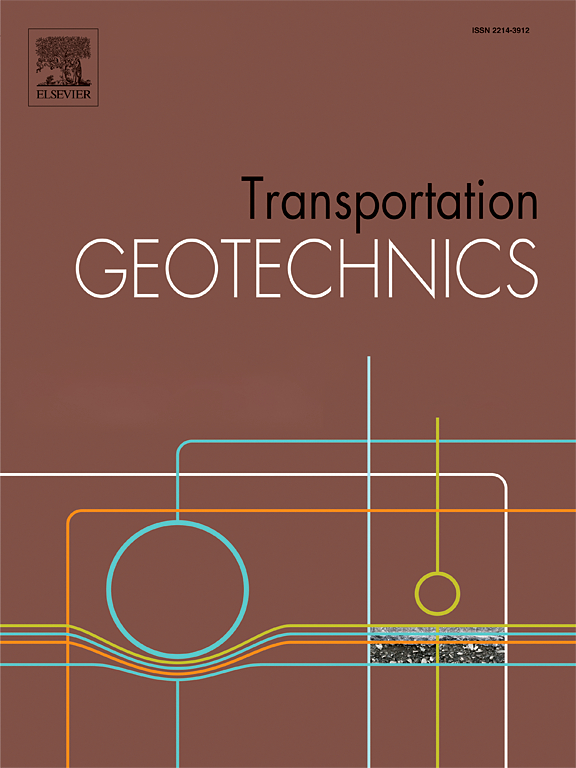Mechanical properties and engineering applications of low-dosage cement/lime-stabilized loess improved with nano-MgO and nan-SiO2
IF 4.9
2区 工程技术
Q1 ENGINEERING, CIVIL
引用次数: 0
Abstract
Loess has poor engineering performance and needs to be improved for engineering applications by adding a large amount of lime or cement, which is not consistent with the goal of “carbon peaking and carbon neutrality”. In this study, nano-SiO2 (NS) and nano-MgO (NM) were applied to improve the engineering performance of low-dosage lime/cement- stabilized loess. The improvement mechanisms of each binder on loess were analyzed by X-ray diffraction (XRD) and scanning electron microscopy-energy dispersive spectrometer (SEM-EDS) tests. The impact of binder dosage and curing time (T) on unconfined compressive strength (UCS), resilient moduli (MR), California bearing ratio (CBR), internal friction angle (φ), cohesion (c), and compression coefficient (a1-2) of each stabilized loess were also explored by conducting a range of laboratory experiments. The results show that the addition of NS did not result in the formation of new substances. However, the formation of MH was noted with the addition of NM. The combination of lime and NS can significantly enhance the UCS, CBR, MR, and c of the stabilized loess, followed by the combination of cement and NS. With the increasing NM content, the above mechanical indices first increased and then decreased for the stabilized loess. Both the binder content and type caused a lesser impact on the φ and a1-2 than on other mechanical indices. Moreover, the mix ratio and feasibility of each stabilized loess applied in various engineering fields were analyzed based on relevant standards and the construction requirements of lime and cement. Finally, estimation models were established for the above mechanical indices of lime-NS stabilized loess, which can provide a reference for engineering design and quality control.
用纳米氧化镁和纳米二氧化硅改善低剂量水泥/石灰稳定黄土的力学性能和工程应用
黄土的工程性能较差,需要通过添加大量石灰或水泥来改善工程应用,这与 "碳峰值和碳中和 "的目标不符。本研究采用纳米二氧化硅(NS)和纳米氧化镁(NM)改善低剂量石灰/水泥稳定黄土的工程性能。通过 X 射线衍射(XRD)和扫描电子显微镜-能量色散光谱仪(SEM-EDS)测试分析了每种粘结剂对黄土的改善机理。此外,还通过一系列实验室实验探讨了粘合剂用量和固化时间(T)对每种稳定黄土的无压抗压强度(UCS)、回弹模量(MR)、加州承载比(CBR)、内摩擦角(φ)、内聚力(c)和压缩系数(a1-2)的影响。结果表明,NS 的添加并没有导致新物质的形成。然而,加入 NM 后,却发现形成了 MH。石灰和 NS 的组合能显著提高稳定黄土的 UCS、CBR、MR 和 c,其次是水泥和 NS 的组合。随着 NM 含量的增加,稳定黄土的上述力学指标先上升后下降。粘结剂含量和类型对φ 和 a1-2 的影响均小于对其他力学指标的影响。此外,还根据相关标准以及施工对石灰和水泥的要求,分析了每种稳定黄土的混合比以及在不同工程领域应用的可行性。最后,建立了石灰-NS 稳定黄土上述力学指标的估算模型,可为工程设计和质量控制提供参考。
本文章由计算机程序翻译,如有差异,请以英文原文为准。
求助全文
约1分钟内获得全文
求助全文
来源期刊

Transportation Geotechnics
Social Sciences-Transportation
CiteScore
8.10
自引率
11.30%
发文量
194
审稿时长
51 days
期刊介绍:
Transportation Geotechnics is a journal dedicated to publishing high-quality, theoretical, and applied papers that cover all facets of geotechnics for transportation infrastructure such as roads, highways, railways, underground railways, airfields, and waterways. The journal places a special emphasis on case studies that present original work relevant to the sustainable construction of transportation infrastructure. The scope of topics it addresses includes the geotechnical properties of geomaterials for sustainable and rational design and construction, the behavior of compacted and stabilized geomaterials, the use of geosynthetics and reinforcement in constructed layers and interlayers, ground improvement and slope stability for transportation infrastructures, compaction technology and management, maintenance technology, the impact of climate, embankments for highways and high-speed trains, transition zones, dredging, underwater geotechnics for infrastructure purposes, and the modeling of multi-layered structures and supporting ground under dynamic and repeated loads.
 求助内容:
求助内容: 应助结果提醒方式:
应助结果提醒方式:


